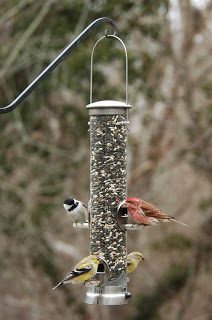How to attract birds to your garden

Birds do more than add to your garden aesthetic. They provide control and conservation but also a real pass-time. Watching my bird bath and feeder has become an interesting portal into the local avian population. Regulars to my oasis include, goldfinches, sparrows, chickadees, house finches, mourning doves and the rare cardinal. They spend their time bouncing from the large stone bird bath to the pear tree, flitting among the leaves of the hydrangeas. Each one with it’s own call and feeder style. My cats also love watching them, call it kitty TV. With this interest I would like to share several of what I consider the how to attract birds to your garden and the key benefits of doing so.
Set up the environment
Cover: Birds need cover, in the spring time to build nests and in the summer, shelter from the sun. Small trees and shrubs offer both. Just keep in mind the proximity to active areas. They may rest on a tree in your busy yard but are not likely to nest.
Water: To drink and to bathe they want it! Even more so if it’s moving water, adding a bubbler to an existing bird bath is one way of achieving an inexpensive water feature. Or if you are looking for a real show stopper incorporate a waterfall into your landscape.
Food: There is cross-purpose here as you will read below. Firstly the biggest draw to your property will always be a deliciously stocked feeder. However, most birds require a mixed diet and will share time spent at the feeder on the ground, amongst your plants pillaging for bugs. Keep feeders clean at all times, mouldy food breeds bacteria. Stock seed based on the types of birds you would like to attract.
Reap the Benefits
Pest Control: Fact is birds eat bugs, aphids, mosquitoes, earwigs, grasshoppers, and spiders to name a few.
Pollination & Augmentation: Nectar sipping and seed spreading are two things that occur when birds go in for a snack. These actions can spread or pollinate meaning more flowers and in turn more birds!!
Education: Bring nature to your door with an active feeder. This is a great way to teach children about local wildlife and conservation. Learning comes alive!
Wildlife Conservation: As more natural habitat is reduced by development or damaged by environmental concerns, a great bird habitat can provide a haven for our feathered friends. Helping to protect the local avian populations.
Stress Relief: There is something so calming about watching a bird flit from feeder to bath. Hopping between garden plants and singing their personal aria. Grab a cup of coffee, sit very still and watch the performance that takes place in your very own theatre garden.

